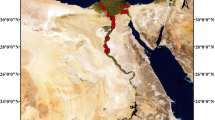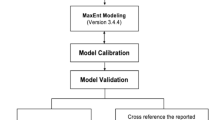Abstract
Intestinal schistosomiasis is a global disease of enormous public health importance. Assessing the local risk of transmission of the parasite causing the disease requires an appraisal of the distribution of its intermediate snail hosts, Biomphalaria spp.. In East Africa, the Lake Victorian Basin is a major freshwater ecosystem and highly endemic for intestinal schistosomiasis, although detailed distribution data for Biomphalaria have not been collected. We used on-the-ground malacological surveys and conjoint measurement of environmental determinants to develop models for analysis of variables associated with distribution and predictive snail mapping into data-deficient areas. Four expeditions were undertaken to collect snails along the Lake Victoria shoreline, visiting 223 sites overall. Environmental measurements were recorded at the time of inspection and water samples taken for quantification of anion and cation concentrations. The spatial distributions of Biomphalaria choanomphala and Biomphalaria sudanica were modelled in two Bayesian multivariate models: one non-spatial and one spatial with random effects. The results showed that chloride, nitrate, sulphate and the number of sympatric snail species were significant predictors of B. choanomphala whereas habitat, water depth, pH and sulphate were significant predictors for B. sudanica. The range of spatial autocorrelation was large (572.9 km for B. choanomphala and 175.3 km for B. sudanica). Interpolating snail abundance data by kriging revealed two ‘hot-spots’ of high abundance of Biomphalaria. These areas should be targeted in future expeditions to ground-truth the model’s predictions. Our study is the first to use Bayesian methods for determination of biomedically important snail distributions and sets crucial limnological baseline data for assessment of future changes in snail biodiversity in the Lake Victoria Basin.




Similar content being viewed by others
References
Allan, F., D. Rollinson, J. E. Smith & A. M. Dunn, 2009. Host choice and penetration by Schistosoma haematobium miracidia. Journal of Helminthology 83: 33–38.
Alves, W., 1958. Chemical constituents of surface water in Southern Rhodesia, with special reference to the molluscan vectors of bilharziasis. Bulletin of the World Health Organization 18: 1071.
Brewer, M. J. & A. J. Nolan, 2007. Variable smoothing in Bayesian intrinsic autoregressions. Environmetrics 18: 841–857.
Brooker, S., 2002. Schistosomes, snails and satellites. Acta Tropica 82: 207–214.
Brown, D. S., 1994. Freshwater Snails of Africa and Their Medical Importance. Taylor & Francis, London.
Bursac, Z., C. H. Gauss, D. K. Williams & D. W. Hosmer, 2008. Purposeful selection of variables in logistic regression. Source Code for Biology and Medicine 3: 17.
Charbonnel, N., M. Quesnoit, R. Razatavonjizay, P. Brémond & P. Jarne, 2002. A spatial and temporal approach to microevolutionary forces affecting population biology in the freshwater snail Biomphalaria pfeifferi. American Naturalist 160: 741–755.
Clements, A. C., N. J. Lwambo, L. Blair, U. Nyandindi, G. Kaatano, S. Kinung’hi, J. P. Webster, A. Fenwick & S. Brooker, 2006. Bayesian spatial analysis and disease mapping: tools to enhance planning and implementation of a schistosomiasis control programme in Tanzania. Tropical Medicine and International Health 11: 490–503.
Clements, A. C. A., S. Brooker, U. Nyandindi, A. Fenwick & L. Blair, 2008. Bayesian spatial analysis of a national urinary schistosomiasis questionnaire to assist geographic targeting of schistosomiasis control in Tanzania, East Africa. International Journal for Parasitology 38: 401–415.
Clements, A. C. A., M. A. Deville, O. Ndayishimiye, S. Brooker & A. Fenwick, 2010. Spatial co-distribution of neglected tropical diseases in the East African Great Lakes region: revisiting the justification for integrated control. Tropical Medicine and International Health 15: 198–207.
Clennon, J. A., C. H. King, E. M. Muchiri, H. C. Kariuki, J. H. Ouma, P. Mungai & U. Kitron, 2004. Spatial patterns of urinary schistosomiasis infection in a highly endemic area of coastal Kenya. American Journal of Tropical Medicine and Hygiene 70: 443–448.
Dalton, P. R. & D. Pole, 1978. Water-contact patterns in relation to Schistosoma haematobium infection. Bulletin of the World Health Organization 56: 417–426.
Erko, B., F. Balcha & D. Kifle, 2006. The ecology of Biomphalaria sudanica in Lake Ziway, Ethiopia. African Journal of Zoology 44: 347–352.
Goldschmidt, T., F. Witte & J. Wanink, 1993. Cascading effects of the introduced Nile Perch on the detrivorous/phytoplanktivorous species in the sublittoral areas of Lake Victoria. Conservation Biology 7: 686–700.
Golez, N. V. & K. Kyuma, 1997. Influence of pyrite oxidation and soil acidification on some essential nutrient elements. Aquacultural Engineering 16: 107–124.
Guimaraes, R. J. P. S., C. C. Freitas, L. V. Dutra, C. A. Felgueiras, A. C. M. Moura, R. S. Amaral, S. C. Drummond, R. G. C. Scholte, G. Oliveira & O. S. Carvalho, 2009. Spatial distribution of Biomphalaria mollusks at Sao Francisco River Basin, Minas Gerais, Brazil, using geostatistical procedures. Acta Tropica 109: 181–186.
Harrison, A. D., W. Nduku & A. S. Hooper, 1966. The effects of a high magnesium-to-calcium ratio on the egg-laying rate of an aquatic planorbid snail, Biomphalaria pfeifferi. Annals of Tropical Medicine and Parasitology 60: 212–214.
Johnson, P. T. J. & D. W. Thieltges, 2010. Diversity, decoys and the dilution effect: how ecological communities affect disease risk. Journal of Experimental Biology 213: 961–970.
Johnson, P. T. J., P. J. Lund, R. B. Hartson & T. P. Yoshino, 2009. Community diversity reduces Schistosoma mansoni transmission, host pathology and human infection risk. Proceedings of the Royal Society B: Biological Sciences 276: 1657–1663.
Jordan, P., G. Webbe & R. F. Sturrock, 1993. Human Schistosomiasis. CAB International, Wallingford.
Joseph, L., T. W. Gyorkos & L. Coupal, 1995. Bayesian estimation of disease prevalence and the parameters of diagnostic tests in the absence of a gold standard. American Journal of Epidemiology 141: 263–272.
Kazibwe, F., B. Makanga, C. Rubaire-Akiiki, J. Ouma, C. Kariuki, N. B. Kabatereine, M. Booth, B. J. Vennervald, R. F. Sturrock & J. R. Stothard, 2006. Ecology of Biomphalaria (Gastropoda: Planorbidae) in Lake Albert, Western Uganda: snail distributions, infection with schistosomes and temporal associations with environmental dynamics. Hydrobiologia 568: 433–444.
Keesing, F., R. D. Hold & R. S. Ostfeld, 2006. Effects of species diversity on disease risk. Ecological Letters 9: 485–498.
Kristensen, T. K., J. B. Malone & J. C. McCarroll, 2001. Use of satellite remote sensing and geographic information systems to model the distribution and abundance of snail intermediate hosts in Africa: a preliminary model for Biomphalaria pfeifferi in Ethiopia. Acta Tropica 79: 73–78.
Lamers, L. P. M., S.-J. Falla, E. M. Samborska, I. A. R. van Dulken, G. van Hengstum & J. G. M. Roelofs, 2002. Factors controlling eutrophication and toxicity in sulphate-polluted freshwater wetlands. Limnology and Oceanography 47: 585–593.
Leisnham, P. T., P. J. Lester, D. P. Slaney & P. Weinstein, 2004. Anthropogenic landscape change and vectors in New Zealand: effects of shade and nutrient levels on mosquito productivity. Ecohealth 1: 306–316.
Lunn, D. J., A. Thomas, N. Best & D. Spiegelhalter, 2000. WinBUGS—a Bayesian modelling framework: concepts, structure, and extensibility. Statistics and Computing 10: 325–337.
Madsen, H., 1990. The effect of sodium chloride concentration on growth and egg laying of Helisoma duryi, Biomphalaria alexandrina and Bulinus truncates. Journal of Molluscan Studies 56: 181–187.
Magendantz, M., 1972. The biology of Biomphalaria choanomphala and B. sudanica in relation to their role in the transmission of Schistosoma mansoni in Lake Victoria at Mwanza, Tanzania. Bulletin of the World Health Organization 47: 331–341.
Mandahl-Barth, G., 1957. Intermediate hosts of Schistosoma: African Biomphalaria and Bulinus: 1. Biomphalaria. Bulletin of the World Health Organization 15: 1103–1163.
Mandahl-Barth, G., 1962. Key to the identification of East and Central African freshwater snails of medical and veterinary importance. Bulletin of the World Health Organization 27: 135–150.
Mkoji, G. M., B. N. Mungai, D. K. Koech & E. S. Loker, 1998. Experimental control of the schistosome-transmitting snail Biomphalaria pfeifferi by the ampullariid snail Pila ovata. Annals of Tropical Medicine and Parasitology 92: 65–72.
Molyneux, D. H., 2003. Common themes in changing vector-borne disease scenarios. Transactions of the Royal Society of Tropical Medicine and Hygiene 97: 129–132.
Norris, D., 2004. Mosquito-borne diseases as a consequence of land use change. Ecohealth 1: 19–24.
Prentice, M. A., 1972. Distribution, prevalence and transmission of schistosomiasis in Uganda. Uganda Medical Journal 1: 136–140.
Raso, G., B. Matthys, E. K. N’Goran, M. Tanner, P. Vounatsou & J. Utzinger, 2005. Spatial risk prediction and mapping of Schistosoma mansoni infections among schoolchildren living in western Cote d’Ivoire. Parasitology 131: 97–108.
Schur, N., L. Gosoniu, G. Raso, J. Utzinger & P. Vounatsou, 2011. Modelling the geographical distribution of co-infection risk from single-disease surveys. Statistics in Medicine 30: 1761–1776.
Schutte, C. H. J. & G. H. Frank, 1964. Observations on the distribution of freshwater mollusca and chemistry of the natural waters in the south-eastern Transvaal and adjacent northern Swaziland. Bulletin of the World Health Organization 30: 389–400.
Smolders, A., E. Lucassen, R. Bobbink, J. Roelofs & L. Lamers, 2010. How nitrate leaching from agricultural lands provokes phosphate eutrophication in groundwater fed wetlands: the sulphur bridge. Biogeochemistry 98: 1–7.
Standley, C. J. & J. R. Stothard, 2010. Towards defining appropriate strategies for targeted NTD control. Tropical Medicine and International Health 15: 772–773.
Standley, C. J., M. Adriko, M. Alinaitwe, F. Kazibwe, N. B. Kabatereine & J. R. Stothard, 2009. Intestinal schistosomiasis and soil-transmitted helminthiasis in Ugandan schoolchildren: a rapid mapping assessment. Geospatial Health 4: 39–53.
Standley, C. J., C. Wade & J. R. Stothard, 2011. A fresh insight into transmission of schistosomiasis: a misleading tale of Biomphalaria in Lake Victoria. PLoS One 6: e26563.
StataCorp, 2009. Stata Statistical Software: Release 11. StataCorp LP, College Station, TX.
Stauffer, J., H. Madsen, K. McKaye, A. Konings, P. Bloch, C. Ferreri, J. Likongwe & P. Makaula, 2006. Schistosomiasis in Lake Malawi: relationship of fish and intermediate host density to prevalence of human infection. Ecohealth 3: 22–27.
Stensgaard, A. S., A. Jørgensen, N. B. Kabatereine, C. Rahbek & T. K. Kristensen, 2006. Modeling freshwater snail habitat suitability and areas of potential snail-borne disease transmission in Uganda. Geospatial Health 1: 93–104.
Stothard, J. R., N. B. Kabatereine, E. M. Tukahebwa, F. Kazibwe, W. Mathieson, J. P. Webster & A. Fenwick, 2005. Field evaluation of the Meade Readiview handheld microscope for diagnosis of intestinal schistosomiasis in Ugandan school children. American Journal of Tropical Medicine and Hygiene 73: 949–955.
Utzinger, J., C. Mayombana, K. Mez & M. Tanner, 1997. Evaluation of chemical and physical-morphological factors as potential determinants of Biomphalaria pfeifferi (Krauss, 1848) distribution. Memorias Do Instituto Oswaldo Cruz 92: 323–328.
Williams, N. V., 1970. Studies on aquatic pulmonate snails in central Africa. I. Field distribution in relation to water chemistry. Malacologia 10: 153–164.
Woolhouse, M. E. J., 1992. Population biology of the freshwater snail Biomphalaria pfeifferi in the Zimbabwe highveld. Journal of Applied Ecology 29: 687–694.
Woolhouse, M. E. J. & S. K. Chandiwana, 1990. Population dynamics model for Bulinus globosus, intermediate host for Schistosoma haematobium, in river habitats. Acta Tropica 47: 151–160.
Yang, G.-J., P. Vounatsou, X.-N. Zhou, M. Tanner & J. R. Utzinger, 2005. A Bayesian-based approach for spatio-temporal modeling of county level prevalence of Schistosoma japonicum infection in Jiangsu province, China. International Journal for Parasitology 35: 155–162.
Acknowledgments
The data presented here were collected with the assistance of extensive field teams from VCD, NIMR and NMK. The water samples were analysed by the NHM’s EMMA laboratories, and we would like to thank Stanislav Strekopytov for all of his hard work processing these. This research was funded by an NHM studentship and EU grant CONTRAST (FP6 STREP contract no: 032203, http://www.eu-contrast.eu).
Author information
Authors and Affiliations
Corresponding author
Additional information
Handling editor: B. Oertli
Nicholas J. S. Lwambo—deceased.
Electronic supplementary material
Below is the link to the electronic supplementary material.
Rights and permissions
About this article
Cite this article
Standley, C.J., Vounatsou, P., Gosoniu, L. et al. The distribution of Biomphalaria (Gastropoda: Planorbidae) in Lake Victoria with ecological and spatial predictions using Bayesian modelling. Hydrobiologia 683, 249–264 (2012). https://doi.org/10.1007/s10750-011-0962-3
Received:
Revised:
Accepted:
Published:
Issue Date:
DOI: https://doi.org/10.1007/s10750-011-0962-3




